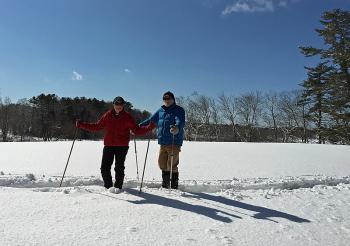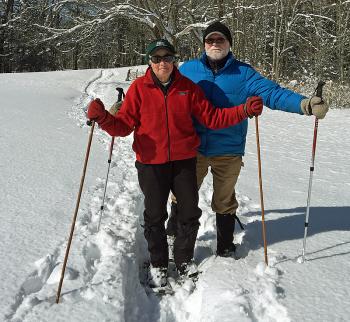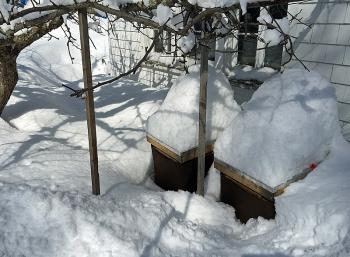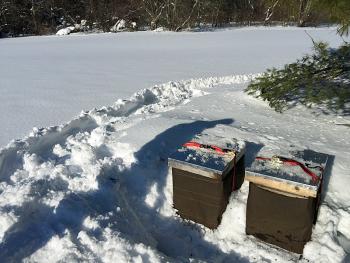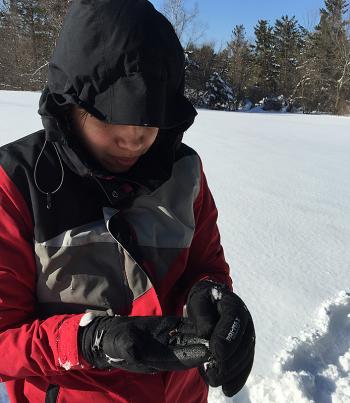The end of February is time to check the honeybees
CAMDEN/ROCKPORT — When the sun is high and warm in the sky on a late February day, and you're a beekeeper, another six inches of fresh snow atop the 3 feet that are already on the ground won't keep you from checking on your girls.
As beekeepers know, this time of year the only bees around are the females. They are the workers, and the queen, and they are doing their best to stay warm, fed and healthy until spring finally arrives. And in Maine, that can be well into March, so the beekeeper better have done their part to help the girls head into winter well prepared or they will find only silence and dead little bees upon the first chance for an inspection.
As for the fact that there are only female bees alive inside an overwintering hive, that will change soon enough. When the time is right, maybe even as February comes to an end, the queen will begin selecting cells in which to begin laying unfertilized eggs.
Those eggs will morph into male bees, called drones, hatch and they will join their sisters in the colony. The drones aren't allowed to remain in the hive over the winter because their only job is to mate with new queens. And being larger than the workers, they consume more food and food can't be wasted on the unnecessary males during a long winter.
The queen doesn't need a male in the hive to make new bees, because in the days after she hatched, she mated with enough drones to store sperm with her eggs to last a lifetime – three to five years. She carries both inside her, and chooses whether to lay fertilized (female) or unfertilized (male) eggs, depending on a variety of circumstances.
There are many hobby honeybee hives around the Midcoast, and nine on them are clustered and dispersed around Camden and Rockport. They are located at a residence on Chestnut Street in Camden, at Merryspring Nature Park, at Aldermere Farm in Rockport and at Erickson Fields on Route 90, also in Rockport. They have become important and recognized pollinators in the neighborhoods they forage, they have provided lots of opportunities for public education and they have also yielded some honey along the way.
Feb. 25 was a perfect day to combine work and pleasure. With a couple pairs of snowshoes borrowed from a friend, the trick to checking on the hives was traversing through the snow to access them.
In one location, it was a climb over snow piled high by the plow trucks. Sad news greeted the beekeeper at this location, as the colonies in both hives were dead, likely from starvation. A final determination won't be made until the weather is a little warmer and the snow is melted to make pulling apart the hives easier. But knowing the likely reason for their demise will be the key to understanding where the beekeeper went wrong with these hives.
Down the road, it was a short but deep trek across a corner of the belted Galloway cattle pasture near Lily Pond to dig out a single hive surrounded by hay bales. Happy news this time, as the bees in that hive were alive and well, though they would likely need some extra food added to the hive at the first real warm day when the hive could be opened without harming the bees.
Food, in the form of many pounds of honey, is left in a hive for the bees to feed upon during the winter. Some beekeepers also add an "emergency" ration of cane sugar, often mounded in a circle between the inner and outer covers. The cane sugar can also be moistened with water into a mixture resembling sand that is then placed within a frame and allowed to dry into solid form. This is called a candy board, and it too is placed under the cover for the bees to access should they run out of stored honey.
Making a note to bring more food out to the field on a future trip, next up was Merryspring, where the snowshoes came in mighty handy to access the two hives there. A portion of the trail to the fields had already been trekked by snowshoe, but nobody had been to the beehive location yet. Exposed to the elements on all but one side, the hives were topped with a foot or more of snow, with snow wrapped around them on two other sides.
A thump on the side did not rise a recognizable humming, and a tip of the outer cover didn't look good, as there were no bees visibly feeding up there. Fairly certain we were going to find a dead hive, the inner cover was boldly lifted, and out flew a dozen or so honeybees, working to protect their colony.
Many of those bees had been clustered on the sunny side of the hive, which was where the sun was warming the black tar paper wrap set up in the fall. That was also the angle from which the top was opened, which only added to the barrage of buzzing bees.
Luckily for the beekeeper, who had turned to look away while a companion dove for cover in the snow, the temperature quickly nabbed the startled bees out of the air before they could find something to sting. And no doubt the layers of winter clothing helped make the beekeepers impervious to worker bees’ defenses.
Gently realigning the covers and securing them tight, it was on to the adjacent hive, which was found to also have a healthy number of bees, like it should this time of year.
Blazing back across the field, it was marvelous to have been the first and only people to have made that trek in quite a while. And the snowshoe hike was made that much sweeter knowing two more colonies of bees had thus far made it through the winter of 2015.
Over at Erickson Fields, there was no way to access the beehives, as nobody has been up to plow the dirt road for weeks, let alone opened the road as it connects to Route 90. So trekking by snowshoe to those two hives will have to wait for another day, and we'll hope those colonies are faring as well as the other surviving colonies we saw.
Back at home, the pair of hives in the backyard have again done well. This has proven to be a good location for honeybee hives, likely benefiting from what little extra warmth Penobscot Bay offers to coastal locations like this. These colonies have also found ample forage, and have been very successful at building up their numbers, which has caused the beekeeper to manage for swarms the past two summers.
While it's always nice to see honeybees making it to this point in the winter season, they still have a ways to go until the snow melts and the first plants they can feed on appear. And while it's sad and frustrating to lose a colony that a beekeeper has spent a season caring for and nurturing, it's comforting to know the surviving colonies will soon feel the need to swarm and will hopefully find the empty hives suitable new homes.
Want to learn more about honeybees and beekeeping? Check out Knox Lincoln County Beekeepers Bee School 2015, with the six-week course beginning Tuesday, March 3.
Related stories:
• Bzzzz, there's a new crop of beekeepers preparing for their bees this spring
• Two new hives of honeybees residing, pollinating in Camden
• Thomaston beekeeper makes quick work of Main Street honeybee swarm in Rockland
• Honeybee swarm catching, I'm adding that to my resume
• The Camden honeybee adventure is alive and well, spreading to Rockport
Recommended:
Reach Editorial Director Holly S. Edwards at hollyedwards@penbaypilot.com


1135.jpg)
